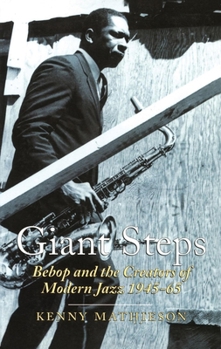Giant Steps: Bebop and the Creators of Modern Jazz, 1945-65
Giant Steps examines the most important figures in the creation of modern jazz, detailing the emergence of bebop through the likes of Dizzy Gillespie, Charlie Parker, Fats Navarro, Bud Powell and Thelonious Monk. Using this as its starting point, Giant Steps subsequently delves into the developments of jazz composition, modal jazz and free jazz. The music of each of these great masters is examined in detail and will provide both a fine introduction for the large audience newly attracted to the music but unsure of their direction through it, as well as an entertaining and informative read for those with a more substantial background.
Format:Paperback
Language:English
ISBN:0862418593
ISBN13:9780862418595
Release Date:August 1999
Publisher:Canongate Books
Length:288 Pages
Weight:0.93 lbs.
Dimensions:1.1" x 5.4" x 8.4"
Customer Reviews
1 rating
A JAZZ REFERENCE WORK DEFINITELY WORTH OWNING
Published by Thriftbooks.com User , 24 years ago
If you have trouble differentiating among Chocolate Williams, Rubberlegs Williams and Horsecollar Williams, here's a volume to straighten you out. In profiling eleven musical thinkers who've helped to shape today's music, Kenny Mathieson enlivens his text with numerous references to other peripheral characters hovering around the scene during the 40s and 50s - for example, "...an unshakably persistent black saxophonist from Newark known as The Demon, whom Dizzy dubbed `the first freedom player - freedom from harmony, freedom from rhythm, freedom from anything.'"Since I've always been intrigued to learn exactly where this music took shape, I was pleased to find references to a long-gone New York club called Snookie's (in which Dizzy's horn was famously bent during a birthday celebration), to the old McKinley Theater in the Bronx (where Bird sat in with the Gillespie big band) and to The Finale, a short-lived spot in LA's Little Tokyo district that Ross Russell termed "a West Coast Minton's". Mathieson even identifies the location of that Harlem chili parlor where Bird had his celebrated epiphany.Hey, did you know that James P. Johnson lived in Manhattan's San Juan Hill near the home where Monk grew up? That Blue Note first recorded Monk at Ike Quebec's urging? That one of Bud Powell's earliest piano heroes was Billy Kyle? That Max Roach served as house drummer at the Lighthouse in Hermosa Beach for six months during the early 50s? That Fats Navarro was Charlie Shavers' third cousin? Or that Chano Pozo's cousin was Chino Pozo? Me, either.Yet despite these fascinating digressions, Mathieson's principal focus remains the recorded output on the eleven players he's elected to spotlight: Gillespie, Parker, Navarro, Powell, Roach, Monk, Mingus, Rollins, Davis, Herbie Nichols and Coltrane. He's chosen this order deliberately - and does manage to provide substantial amounts of information on other key players throughout (for example, on Clifford Brown in the chapter on Roach and on Tadd Dameron in the section on Navarro).As Mathieson notes, no one much under seventy is likely to have heard Parker during his peak years - and no one much under fifty will have experienced Coltrane live. Consequently, the recordings left by these prime movers is the closest most of us can ever get to them. His stress, therefore, is on those recordings, with enlightening reference to the circumstances surrounding them.Mathieson says that the last roughly comparable venture he's aware of was the Jazz Masters series originally published by Macmillan in the mid-60s. His aim, he adds, was to make this volume accessible to readers with no technical knowledge of music. Still, I doubt that Giant Steps would serve as a good introduction to jazz for someone who hasn't already listened carefully to lots of it.Salted throughout are aptly chosen quotes from other jazz writers. But I found many of the author's own observations on these players, their recordings and their le





